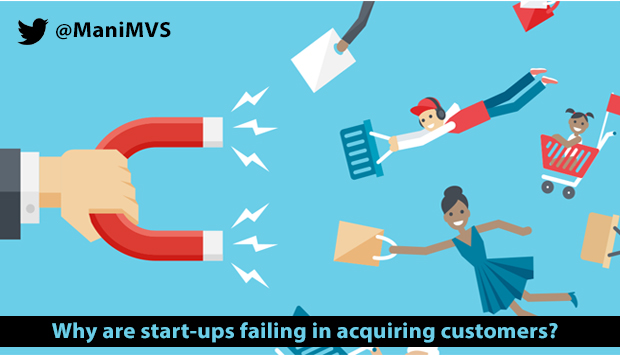Why are start-ups failing in acquiring customers?
This owner of a garage startup has topped Forbes richest man’s list this year for no umpteen reason. He could do it because he knew how to smash-up those tricky startup challenge of customer acquisition and grow manifold within years. And wonder what he believes in when it comes to his business growth? He says, “If there’s one reason we have done better than of our peers in the Internet space over the last six years, it is because we have focused like a laser on customer experience, and that really does matter, I think, in any business. It certainly matters online, where word of mouth is so very, very powerful.” — yes! We are referring to Jeff Bezos, Founder and CEO, Amazon.com, currently the second-largest private employer in the United States.
Today, we will talk about 4 points that are obtrusively failing startups in their life long goal of sustenance and acquisition of customers:
Failing to create ‘Real Products’
The secret behind creating real products is to transform ideas that solve actual pain points or helps even a bit. A pain point is not just the problem you solve for your customer, but the specific reason they finally choose to use your product. Most startups fail to do so. Even if they end up creating one, they can’t find innovative, early-adopters within their target market.
Inability to set clear expectations with the customers results in disinterested customers! Lets look at what a popular beauty brand did!. For e.g. Pantene, the hair care brand, used contextually based mobile advertising, real-time location-based data and strategic partnerships with Walgreens, the US pharmacy chain, and The Weather Channel to address a key consumer pain point – ‘bad hair days’. Upon checking the daily forecast on The Weather Channel, mobile phone users were served a personalised “haircast” with suggestions for the most appropriate Pantene product to suit the conditions outside. Quite innovative, right?
Inability to choose target group appropriately
It’s just a fact that most early stage startups go after the wrong customer segment at first. They are not open to sharing product details with all and more often Talk More and Listen Less’ when the opposite is what is necessary. Hence they are not able to analyze the acceptability of their creation. In most cases, they don’t ask customers their challenges, what value they would potentially see in their product, and if they’d be willing to test it. They often fail to track most of the feedback, find similarities in them and most importantly figure out what those specific individuals have in common. This way they miss to locate their probable target market entirely.
Random marketing moves
Most startups start spending before even understanding their target group. Instead of figuring out where they’re spending their time online, how they are communicating with each other or what events they are attending, they jump on executing random marketing strategies. Not being tactical and focused in their outreach is another grave issue. When the cost to acquire customers is greater than the company’s ability to monetize those customers, the business model fails. For most startups, first customer acquisition is most likely going to be harder than you originally envisioned. But a majority of the newbie fail to understand this fact and let this govern their willingness to better their product, strategy or spending motives.
Startups don’t realize that their shoestring budget can’t keep them from carving out their own niche if they really want it. Most of them don’t ideate around it.
Blurred and Inadequate Communication Strategy
If you look at the communication strategy of many of the startups, you would notice that they try to guide the customers instead of informing them. Customers are not allowed to make their own judgement and they perceive the company as a pushy advertiser trying just to sell their product somehow. Even when startups generate customer interest, they mostly don’t get back to their queries and cultivate delay. Sometimes, they are seen to hold back important information about their product/service too which ends up in annoying the customer. Even if they do, they use negative verbatim when communicating.
Conclusion
Startups, big and small have both felt the withdrawal pangs at some point. Flipkart struggled to raise funds and saw its valuation slashed repeatedly. Japanese giant SoftBank wrote down US$550 million in its biggest India investments, Snapdeal and Ola. 2015 had 11 startups closing their doors and 2016 an alarming 25. Well that’s not the end of the story – India has added over 1000 startups in 2017 with rising focus on new-age advanced-tech startups (Nasscom). No matter what, dreams will unfold and transform into reality only if one can tame the slight glitch in their customer acquisition strategy.
The original article appeared on Bizztor




Leave Your Comments